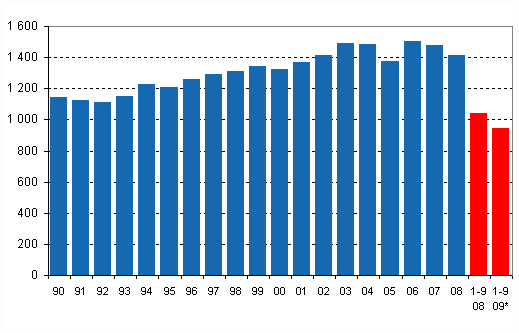This set of statistics has been discontinued.
New data are no longer produced from the statistics.
Published: 16 December 2009
Total energy consumption fell by 9 per cent in January to September
According to Statistics Finland's preliminary data, total energy consumption amounted to 950 petajoule over the first three quarters of 2009, which was 9 per cent less than over the corresponding period of the year before. Electricity consumption decreased by 10 per cent over the same time period. Carbon dioxide emissions from the production and use of energy diminished by 6 per cent.
Total energy consumption, petajoule (1 petajoule = 1,000 terajoule)

Share of renewable energy on the decline
Emissions decreased by less than energy consumption because the share of fossil energy sources grew and that of renewable energy sources diminished in energy production. The consumption of natural gas fell by 15 per cent and that of oil by 5 per cent, whereas the consumption of coal (includes here coal, coke, and blast furnace and coke oven gas) went up by 12 per cent. The combined share of these of total consumption rose up from 45 to 47 per cent. Consumption of peat diminished by 28 per cent.
Diminished water resources from the year before reduced the production of hydro power by over 20 per cent. The use of wood-based fuels decreased by 22 per cent due to the fallen output of the pulp and paper industry. Among renewable energy sources the use of wind power showed 16 per cent growth. Altogether 0.4 per cent of all electricity produced in Finland was produced with wind power.
In consequence of the economic recession especially industry's electricity consumption decreased from the previous year. Net imports of electricity decreased by 18 per cent as imports contracted by 8 per cent and exports of electricity grew by over 70 per cent. Imports covered 16 per cent of the total consumption of electricity.
Non-uniform price development
The price of coal was falling steadily throughout the examined time period. The price of natural gas was also falling right up to the summer but then started to rise slowly in the autumn. Risen price of crude oil has been pushing the prices of heavy and light fuel oils up since the turn of the year. Among transport fuels the price of motor gasoline was rising up to the summer. By contrast, the price of diesel fuel has stayed at the same level where was at the turn of the year. The price of diesel fuel is kept down by fallen demand from heavy transport vehicles and oversupply of refinery capacity. Despite the non-uniform price development the prices of these transport and power plant fuels are clearly lower now than they were over the same time period of last year.
In September the price of electricity had halved year-on-year on the Nordic electricity exchange Nord Pool. Since December 2008 the fall amounted to over 20 per cent. The prices of emission right have also remained clearly lower than last year. They were at their lowest in February but have since risen by approximately 40 per cent to their current level. The prices of emission rights are still clearly lower than in the year before.
Sources: Energy supply, consumption and prices 2009, 3rd quarter. Statistics Finland
Inquiries: Mr Anssi Vuorio +358 9 1734 2685, energia.tilastokeskus@stat.fi
Director in charge: Leena Storgårds
- Tables
-
Appendix tables
- Table 01. Total Energy Consumption by Source (Excel) (16.12.2009)
- Table 02. Supplies and Total Consumption of Electricity (Excel) (16.12.2009)
- Table 03. Energy Imports by Country of Origin January-September 2009 (Excel) (16.12.2009)
- Table 04. Energy Exports by Recipient Country January-September 2009 (Excel) (16.12.2009)
- Table 05. Consumer Prices of Liquid Fuels (Excel) (16.12.2009)
- Table 06. Consumer Prices of Hard Coal, Natural Gas and Domestic Fuels in Heat Production (Excel) (16.12.2009)
- Table 07. Price of Natural Gas by Type of Consumer (Excel) (16.12.2009)
- Table 08. Price of Electricity by Type of Consumer (Excel) (16.12.2009)
- Table 09. Price of District Heating by Type of Consumer (Excel) (16.12.2009)
- Table 10. Excise Taxes, Value Added Taxes and Fiscal Charges and Fees Included in Consumer Prices of Some Energy Sources (Excel) (16.12.2009)
- Table 11. Energy Taxes, Precautionary Stock Fees and Oil Pollution Fees (Excel) (16.12.2009)
- Figures
-
- Figure 01. Changes in GDP, Final energy consumption and electricity consumption 1995-, % (16.12.2009)
- Figure 02. Carbon dioxide emissions from fossil fuels and peat use 1990-, Mt (16.12.2009)
- Figure 03. Coal consumption 1993-, mill. t (16.12.2009)
- Figure 04. Consumption of natural gas 1993-, bn m3 (16.12.2009)
- Figure 05. Peat consumption 1993-, TWh (16.12.2009)
- Figure 06. Domestic oil deliveries 1993-, mill. t (16.12.2009)
- Figure 07. Import prices of oil 1997-, /t (16.12.2009)
- Figure 08. Consumer prices of principal oil products 1995-, c/l (16.12.2009)
- Figure 09. Fuel Prices in Heat Production 1995-, /MWh (16.12.2009)
- Figure 10. Fuel prices in electricity production 1995-, /MWh (16.12.2009)
- Figure 11. Price of electricity by type of consumer 1994-, c/kWh (16.12.2009)
- Figure 12. Average monthly spotprices at the Nord Pool power exchange 1998-, /MWh (16.12.2009)
Last updated 16.12.2009
Statistics:
Energy supply, consumption and prices [e-publication].
ISSN=1798-338X. 3rd quarter 2009. Helsinki: Statistics Finland [referred: 19.4.2024].
Access method: http://www.stat.fi/til/ehkh/2009/03/ehkh_2009_03_2009-12-16_tie_001_en.html?tulosta

